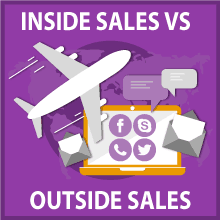
The problem of inside sales vs outside sales is defined by technological progress.
What would be considered a productive sales team just ten years ago is drastically different from a productive sales team today. The landscape of the sales industry has changed.
Today more and more deals are closed via email, chat and on Skype calls; meeting clients face to face is seemingly old-school. So does this mean the inside sales vs outside sales debate over? The stats will probably surprise you.
In this post we’re going to discuss the current state of sales, tips on finding the right mix of sales reps for your company, and why inside sales and outside sales are becoming more inseparable with each passing day.
Let’s talk about definitions first
A lot of people don’t understand the difference between inside sales vs outside sales. So let’s give clear definitions to those terms and define some of their key characteristics to eliminate any confusion.
Inside sales is the process of closing deals remotely, mainly over the internet. Inside sales are defined by convenience. A professional inside sales rep can be working with dozens of clients and hundreds of prospects at the same time from the comfort of their office.
Inside sales reps have a fixed schedule and similar processes that they apply to all of their potential clients. It usually begins with prospecting, finding new leads, reaching out to them via a cold email, a cold call or some other means, and scheduling a demo and trying to convert them to a customer.
Outside sales is the traditional, time-honored approach to sales. It’s defined by meeting clients face to face, traveling and discussing deals over lunches and dinners.
This is the reason why outside sales reps have a more improvisational schedule and they tend to take each individual client’s needs and preferences into account more. As outside sales reps have direct access to a potential client, they can take advantage of additional means of persuasion, like testing a product in real life.

The state of inside sales vs outside sales today
Inside sales have been skyrocketing throughout the last decade. By Salesloft’s account, inside sales are growing fifteen times faster than outside sales. For every outside sales rep hired, companies are bringing 10 inside sales reps on board.
The two categories are racing towards what InsideSales.com calls ‘an equilibrium’, with inside and outside sales sharing a 50-50 split in the next couple of years. HubSpot shows that in 2018 approximately 57% of sales reps are working on outside sales, while 43% of sales reps are responsible for the inside sales.
The reason for the growth of inside sales segment is pretty clear. Sales Benchmark Index shows that 75% of clients on average don’t want to spend time in meetings with your sales reps, preferring to discuss deals remotely. In addition, Inbound Seller indicates that inbound lead generation is massively more cost-effective than the outbound alternative, with a 61% reduction in costs after the switch from outside to inside sales.
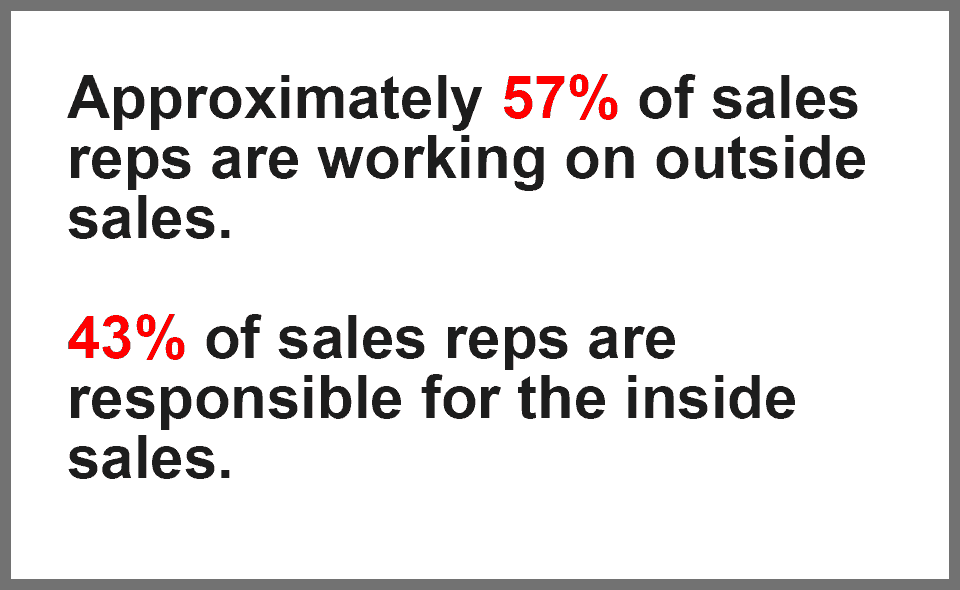
What’s interesting is that the outside sales field is basically converging with inside sales. HubSpot noticed that since 2013 more and more outside sales reps have started using remote selling techniques, and by 2018 they are spending 45% of their working time on what could be called inside sales.
With the advent of new technologies, it’s becoming more and more cost-effective and easier to provide quality sales service remotely, be it via email, Skype, chat, etc. And there is no indication that the progress will stop.
But if you decide after reading this that outside sales have gone the way of the dinosaur, you’re mistaken.
The key difference between inside sales vs outside sales
Outside sales are far better when it comes to large-scale deals and corporate clients.
Here’s a statistic to highlight that distinction. Outside sales reps work on deals that tend to be north of $35,000 — on average, 130.2% higher than those that are achieved by an inside sales teams (HubSpot). What’s more, the close rate for those deals tends to be 30% higher than the close rate of inside sales reps (Spotio).
Another important distinction lies in salaries. Although with the evolution of the internet the need for outside sales is falling, salaries are usually higher for outside sales personnel due to a variety of reasons (like the need for traveling and accommodations). Salesloft reports that salaries for outside sales reps are up to 18% higher than salaries of the inside sales reps.
With that said, we can define key distinctions between inside and outside sales:
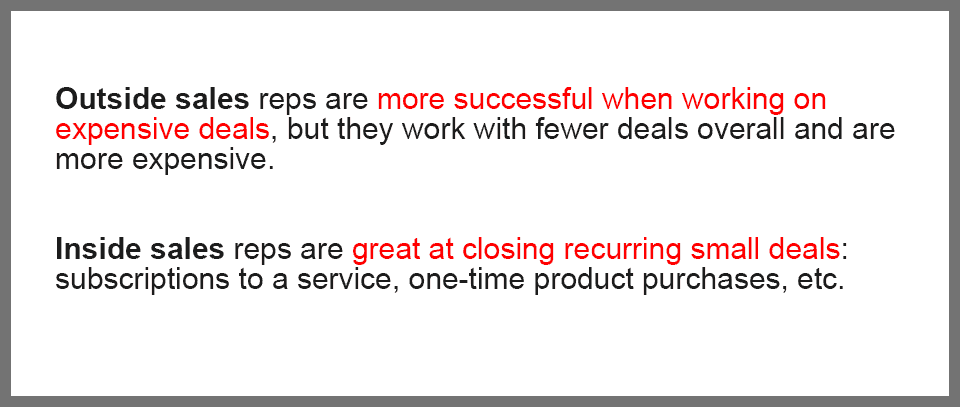
Tips on hiring inside sales vs outside sales reps
So how does a productive sales team look like today? Let’s talk about some of the things you should take into account when hiring sales reps.
1) Evaluate your core sales mission
When looking at statics on the state of inside sales vs outside sales, it’s easy to start making general assumptions about how the industry should look and which sales reps you should hire.
But here’s the truth: as each company is wildly different from the next one, the type of sales reps you need to hire is dictated by your industry and clients — not by the statistics.
That’s why although many articles talk about an ‘ideal split’ of 50-50 between inside and outside sales, don’t be afraid to reject this model if you feel like it doesn’t make sense to you or your organization.
In short, if you’re selling digital services, most (if not all) of your sales reps should work in inside sales. If you’re selling material, expensive goods (like cars), most of your sales reps should work in outside sales.
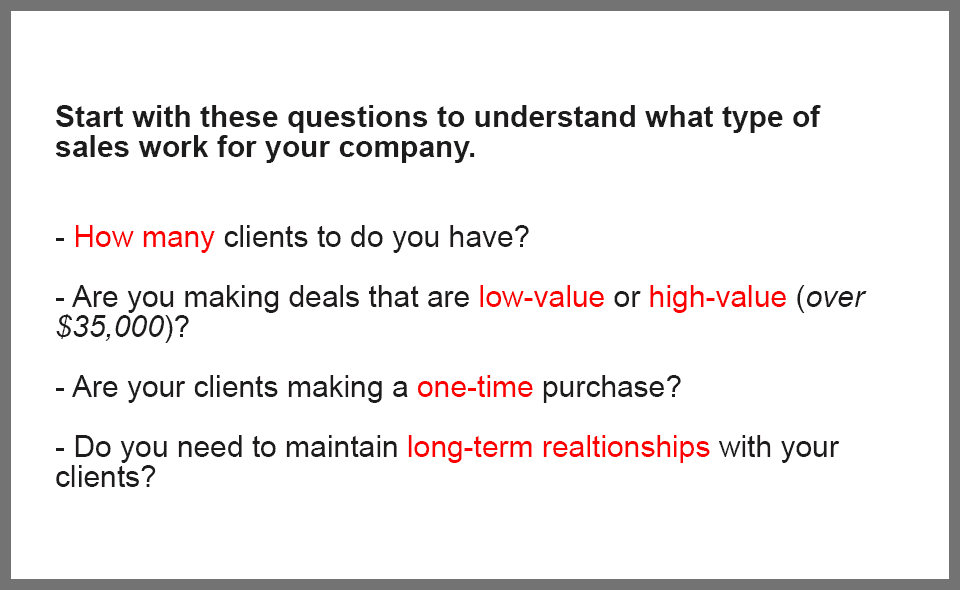
You don’t want to hire a department full of inside sales reps when you actually want to make only a couple of deals per year. And you don’t need a full team of outside sales reps if you’re not meeting with clients.
2) Futureproof your sales department
Look, there’s no other way of saying this – inside sales is here to stay. And it’s only going to get bigger in the coming years, probably taking over the 50% split at some point.
Blame technological progress. As we’ve said before, more than 75% of clients already don’t want to meet with sales representatives. Emails or video chats are quicker and easier, allowing customers to interact with your sales on their terms.
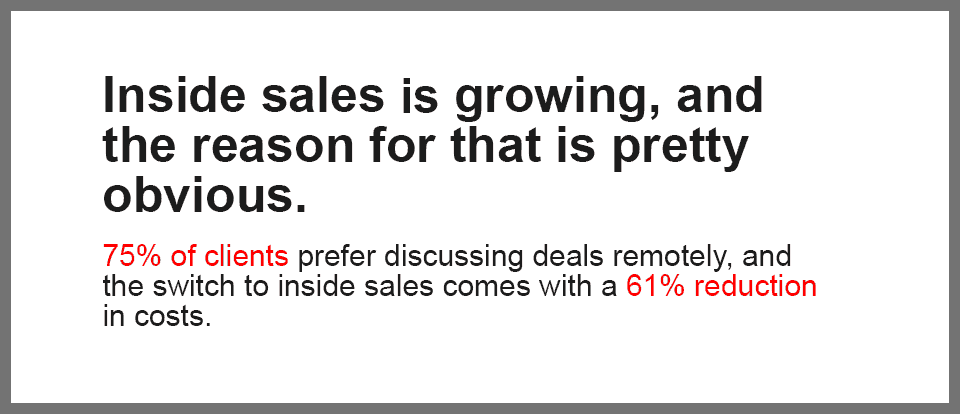
Once again, this doesn’t mean that outside sales is going to disappear. It will still be required for bigger deals. But the definition of ‘a bigger deal’ is going to change. According to HubSpot, outside sales reps usually work on deals worth $35,000 or more. But in the future, these types of deals will become pricier, as more and more people will feel comfortable spending a larger amounts of money online.
BDC also noticed that 74% of business buyers look for information on a product they are planning to buy online, even if the deal is going to take place offline. If you’re not focusing at least some effort on online prospecting, procurement and pipeline management, you’re losing on a big chunk of potential clients.
Social networks are continuing to grow, and they are an essential part of an inside sales department’s toolset. For example, Rain Group proclaimed that LinkedIn has ‘changed the game’ of sales itself, so not using it to acquire and convert new clients will be a mistake in the long run (if you’re not sure how to use LinkedIn to optimize your sales approach, read our post on this).
Basically, all of this means that inside sales reps are essential for growth, even if you’re working primarily on outside sales today.
3) You’re probably going to start with inside sales anyway (and that’s OK)
Probably the most important question to consider before going on a hiring spree is the question of resources. Can your budget support the team of your dreams?
If your company is new, chances are that you’re going to want to start hiring inside sales reps first. There are a variety of reasons why that makes sense. They are cheaper, more versatile, and most customers prefer discussing deals remotely.

In general, outside sales reps are pricier than inside sales reps. In the U.S., the average salary of an inside sales representative is $43,000 (Glassdoor), while the average salary for an outside sales representative is $53,000 (PayScale). That’s before we take into account various expenses they need to do their jobs, like traveling and accommodation, etc.
But higher salary and more experience (which outside sales reps usually possess) do not automatically translate into more deals. You can’t expect that one outside sales rep will bring you more clients and money than a team working on inside sales.
Besides, inside sales are easily trackable. A lot of tools (like Sales Navigator’s SSI) allow you to track the performance of your sales rep directly. You can put that data in use and change your overall sales strategy quicker. This is especially important during the initial stages of growth for your company.
4) Aim for a sales hybrid
It might seem like there is a clear distinction between inside sales vs outside sales. But the reality is quite different.
The lines between those two fields are more blurred than ever. For example, meeting clients face to face is traditionally a core part of outside sales. But today you can be closing deals on Skype. This means you have all the advantages of an outside sales process but from the comfort of your office.
On the other hand, inside sales techniques are now more inseparable from the modern outside sales workflow than ever. Even if outside sales reps spend a majority of their time meeting with clients, they still discuss those meetings via email, schedule remote demos when meetings fall through, etc.
The research of InsideSales.com shows that outside sales reps spend half of their time selling remotely. Only five years ago, this amount of time was 89% less.
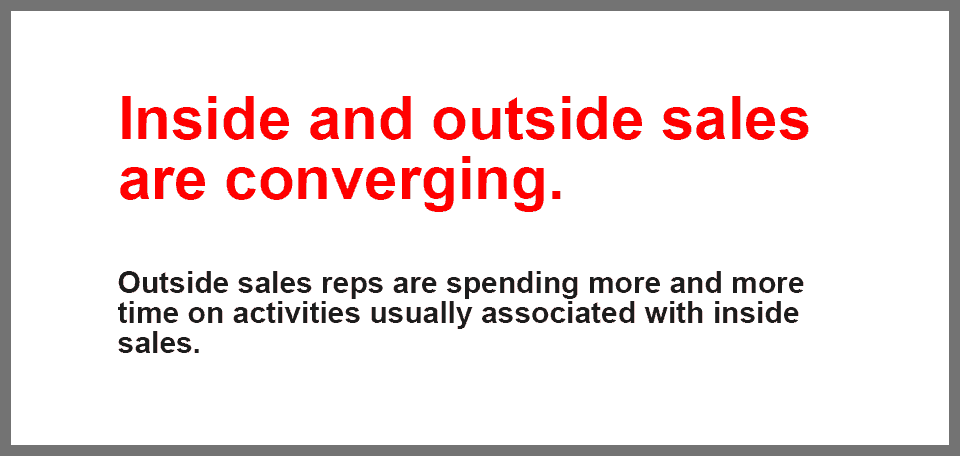
In the current era, your sales reps should possess skills for both outside and inside selling. So what should you do? You can actively search for people possessing both skill sets when hiring, creating a ‘hybrid’ sales department from the start. If that doesn’t work, encourage your sales team to expand their knowledge of different sales techniques — or spend some time creating an interdependent relationship between the two departments.
Conclusions
Obviously, every business will structure its sales teams differently to meet their needs. While some will reach deals exclusively over cold emails, others will continue to rely on outside sales as their defining strategy.
On the other hand, technological progress is going to continue changing the sales industry. That’s why no matter what type of business you own, if you want your hires to be future proof, stay up-to-date and pay attention to modern inside sales techniques.
Have your own take on inside sales vs outside? Share it with us in the comments section below!

Leave a Reply